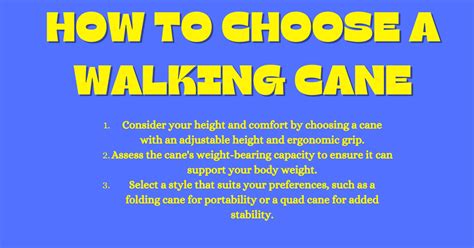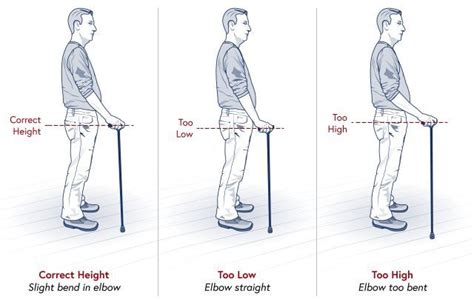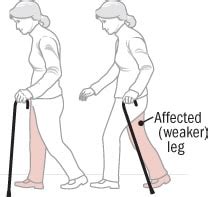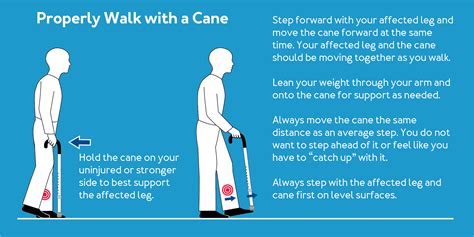Intro
Learn proper cane usage techniques to improve mobility and reduce injury risk, including correct grip, posture, and walking methods for safe and effective ambulation with a walking cane.
Using a cane correctly is crucial for individuals who require assistance with mobility, balance, or stability. A cane can be an essential tool for people with injuries, disabilities, or age-related mobility issues, providing support and confidence to navigate daily activities. However, using a cane incorrectly can lead to accidents, injuries, or worsening of existing conditions. In this article, we will explore the importance of using a cane correctly, its benefits, and provide step-by-step guidance on how to use a cane safely and effectively.
The correct use of a cane can significantly improve mobility, reduce the risk of falls, and enhance overall quality of life. A cane can help individuals with mobility issues to walk more comfortably, maintain balance, and perform daily tasks with greater ease. Moreover, using a cane correctly can also help to reduce the strain on joints, muscles, and bones, which can be particularly beneficial for people with conditions such as arthritis, osteoporosis, or chronic pain. By learning how to use a cane correctly, individuals can regain their independence, confidence, and mobility, enabling them to participate in activities they enjoy and maintain a healthy, active lifestyle.
Using a cane correctly requires attention to several key factors, including the type of cane, its height, and the technique used to walk with it. There are various types of canes available, each designed to meet specific needs and preferences. For example, standard canes, offset canes, and quad canes are popular options, each offering unique features and benefits. The height of the cane is also critical, as it should be adjusted to allow the user to stand upright with a slight bend in the elbow. Additionally, the technique used to walk with a cane is essential, as it should be used to support the weaker side of the body and help with balance and stability.
Choosing the Right Cane

Features to Consider
When choosing a cane, there are several features to consider, including the material, weight, and handle type. Canes can be made from various materials, such as wood, aluminum, or carbon fiber, each offering unique benefits and drawbacks. For example, wooden canes are often preferred for their aesthetic appeal and comfort, while aluminum canes are lightweight and durable. The weight of the cane is also an essential factor, as it should be lightweight enough to be easily manageable yet sturdy enough to provide support. Additionally, the handle type is critical, as it should be comfortable to grip and easy to maneuver.Adjusting the Cane to the Correct Height

Measuring the Cane
To ensure the cane is adjusted to the correct height, individuals can measure the distance from the floor to the top of the leg, just above the wrist. This measurement can be used to adjust the cane to the correct height, taking into account the user's shoe height and arm length. It is essential to note that the cane should be adjusted while the user is standing upright, as this will provide the most accurate measurement.Using the Cane Correctly

Walking with the Cane
Walking with the cane requires a smooth, rhythmic motion, with the cane and legs moving in unison. The cane should be kept close to the body, with the tip of the cane pointing forward. When turning, the cane should be moved in the direction of the turn, with the body following. It is essential to avoid leaning on the cane or using it as a crutch, as this can lead to accidents and injuries.Maintenance and Care of the Cane

Replacing the Cane
Replacing the cane is essential when it shows signs of wear and tear or no longer provides the necessary support and stability. A new cane should be chosen based on the user's changing needs and preferences, taking into account factors such as mobility, balance, and lifestyle. It is essential to consult with a healthcare professional or mobility specialist to ensure the new cane meets the user's unique requirements and provides the necessary support and stability.Benefits of Using a Cane Correctly

Improved Mobility
Improved mobility is one of the primary benefits of using a cane correctly. A cane can help individuals with mobility issues to walk more comfortably, climb stairs, and perform daily tasks with greater ease. By providing support and stability, a cane can enable users to move around with greater confidence, reducing the risk of falls and injuries. Additionally, a cane can help to reduce the strain on joints, muscles, and bones, which can be particularly beneficial for people with conditions such as arthritis, osteoporosis, or chronic pain.Common Mistakes to Avoid

Preventing Falls
Preventing falls is crucial when using a cane, as falls can lead to serious injuries, particularly in older adults or individuals with mobility issues. To prevent falls, individuals should always use their cane on the correct side, hold the cane correctly, and walk with a smooth, rhythmic motion. Additionally, individuals should be aware of their surroundings, avoiding obstacles, uneven surfaces, and slippery floors. By taking these precautions, individuals can reduce the risk of falls and injuries, ensuring safe and effective use of their cane.What are the benefits of using a cane correctly?
+Using a cane correctly can improve mobility, balance, and stability, reducing the risk of falls and injuries. It can also help to reduce the strain on joints, muscles, and bones, and enable individuals to maintain their independence and quality of life.
How do I choose the right cane for my needs?
+Choosing the right cane involves considering factors such as mobility needs, preferences, and lifestyle. Individuals should consult with a healthcare professional or mobility specialist to determine the most suitable type of cane and adjust it to the correct height.
What are common mistakes to avoid when using a cane?
+Common mistakes to avoid when using a cane include using the cane on the wrong side, holding the cane too tightly, and walking with an uneven gait. Individuals should also be aware of their surroundings, avoiding obstacles, uneven surfaces, and slippery floors.
In conclusion, using a cane correctly is essential for individuals who require assistance with mobility, balance, or stability. By choosing the right cane, adjusting it to the correct height, and using it correctly, individuals can improve their mobility, balance, and stability, reducing the risk of falls and injuries. We invite you to share your experiences and tips on using a cane correctly, and to ask any questions you may have on this topic. Your input and feedback are invaluable in helping us to provide the most accurate and helpful information possible.
